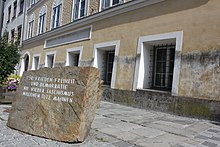Braunau am Inn
While the abbey of Ranshofen was already mentioned in the course of the deposition of Tassilo III, Duke of Bavaria, in 788, Braunau itself first appeared as Prounaw in an 1120 deed.
The Late Gothic Braunau parish church dedicated to Saint Stephen was built from 1439 to 1466, replacing an older chapel.
Within 40 years, Braunau changed hands three times: In 1779, it became an Austrian town under the terms of the Treaty of Teschen, which settled the War of the Bavarian Succession.
During War of the Third Coalition, the Nuremberg bookseller Johann Philipp Palm was arrested at the Braunau fortress by French troops and executed for high treason by personal order of Napoleon in 1806.
In 1816, during reorganisation of Europe after the Napoleonic Wars at the Congress of Vienna, the Kingdom of Bavaria ceded the town to the Austrian Empire and was compensated by the gain of Aschaffenburg.
[4] In April 1938, Braunau renamed Salzburger Vorstadt to Adolf-Hitler-Straße, and its town plaza to Adolf-Hitler-Platz,[5] but the building itself remained a Gasthaus, with a sign advertising beer on tap.
[6] That same year, Hitler's personal secretary Martin Bormann purchased the house on behalf of the Nazi Party,[7] it then became a cult centre containing an art gallery and a public library.
At the end of World War II in 1945, American soldiers occupied the house and prevented Nazi supporters from blowing it up.
In 1952, it was repurchased by its former owners, the Pommer family,[7] and thereafter was used as a city library, a technical college and lastly a day-care centre for disabled people (Lebenhilfe).
[7] In 1972 the Austrian Ministry of the Interior took over the main lease on the building to further discourage any notion of making it a pilgrimage site, and thereafter paid its owner approximately 4,800 euros in monthly rental.
[9] In the process of coming to terms with the history of Austria in the time of National Socialism, the mayor of Braunau, Gerhard Skiba, presided over the installation of the Hitler birthplace memorial stone in front of the building.
[7] At the same time, an Austrian governmental commission was considering a number of options for the future of the house, turning it into apartments again, using it for a center or a museum that would confront Austria's Nazi past, and even its demolition, replacing the original building with an entirely new structure.
After two successful seasons, the local football team, SV Braunau, reached the Austrian 1st Division before suddenly going bankrupt in 2000.



